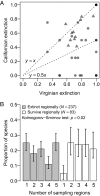Convergence, divergence, and parallelism in marine biodiversity trends: Integrating present-day and fossil data
- PMID: 25901312
- PMCID: PMC4413324
- DOI: 10.1073/pnas.1412219112
Convergence, divergence, and parallelism in marine biodiversity trends: Integrating present-day and fossil data
Abstract
Paleontological data provide essential insights into the processes shaping the spatial distribution of present-day biodiversity. Here, we combine biogeographic data with the fossil record to investigate the roles of parallelism (similar diversities reached via changes from similar starting points), convergence (similar diversities reached from different starting points), and divergence in shaping the present-day latitudinal diversity gradients of marine bivalves along the two North American coasts. Although both faunas show the expected overall poleward decline in species richness, the trends differ between the coasts, and the discrepancies are not explained simply by present-day temperature differences. Instead, the fossil record indicates that both coasts have declined in overall diversity over the past 3 My, but the western Atlantic fauna suffered more severe Pliocene-Pleistocene extinction than did the eastern Pacific. Tropical western Atlantic diversity remains lower than the eastern Pacific, but warm temperate western Atlantic diversity recovered to exceed that of the temperate eastern Pacific, either through immigration or in situ origination. At the clade level, bivalve families shared by the two coasts followed a variety of paths toward today's diversities. The drivers of these lineage-level differences remain unclear, but species with broad geographic ranges during the Pliocene were more likely than geographically restricted species to persist in the temperate zone, suggesting that past differences in geographic range sizes among clades may underlie between-coast contrasts. More detailed comparative work on regional extinction intensities and selectivities, and subsequent recoveries (by in situ speciation or immigration), is needed to better understand present-day diversity patterns and model future changes.
Keywords: biogeography; diversification; extinction; latitudinal diversity gradient; marine biodiversity.
Conflict of interest statement
The authors declare no conflict of interest.
Figures



Similar articles
-
Out of the tropics, but how? Fossils, bridge species, and thermal ranges in the dynamics of the marine latitudinal diversity gradient.Proc Natl Acad Sci U S A. 2013 Jun 25;110(26):10487-94. doi: 10.1073/pnas.1308997110. Epub 2013 Jun 12. Proc Natl Acad Sci U S A. 2013. PMID: 23759748 Free PMC article.
-
Shaping the Latitudinal Diversity Gradient: New Perspectives from a Synthesis of Paleobiology and Biogeography.Am Nat. 2017 Jan;189(1):1-12. doi: 10.1086/689739. Epub 2016 Dec 2. Am Nat. 2017. PMID: 28035884 Review.
-
Loss of Biodiversity Dimensions through Shifting Climates and Ancient Mass Extinctions.Integr Comp Biol. 2018 Dec 1;58(6):1179-1190. doi: 10.1093/icb/icy111. Integr Comp Biol. 2018. PMID: 30204879
-
Ecologically diverse clades dominate the oceans via extinction resistance.Science. 2020 Feb 28;367(6481):1035-1038. doi: 10.1126/science.aax6398. Science. 2020. PMID: 32108111
-
Why are there so many insect species? Perspectives from fossils and phylogenies.Biol Rev Camb Philos Soc. 2007 Aug;82(3):425-54. doi: 10.1111/j.1469-185X.2007.00018.x. Biol Rev Camb Philos Soc. 2007. PMID: 17624962 Review.
Cited by
-
A promising future for integrative biodiversity research: an increased role of scale-dependency and functional biology.Philos Trans R Soc Lond B Biol Sci. 2016 Apr 5;371(1691):20150228. doi: 10.1098/rstb.2015.0228. Philos Trans R Soc Lond B Biol Sci. 2016. PMID: 26977068 Free PMC article. Review.
-
Extinction and morphospace occupation: A critical review.Camb Prism Extinct. 2023 Jun 26;1:e17. doi: 10.1017/ext.2023.16. eCollection 2023. Camb Prism Extinct. 2023. PMID: 40078690 Free PMC article. Review.
-
Integrating cryptic diversity into coral evolution, symbiosis and conservation.Nat Ecol Evol. 2024 Apr;8(4):622-636. doi: 10.1038/s41559-023-02319-y. Epub 2024 Feb 13. Nat Ecol Evol. 2024. PMID: 38351091 Review.
-
Testing the occurrence of convergence in the craniomandibular shape evolution of living carnivorans.Evolution. 2021 Jul;75(7):1738-1752. doi: 10.1111/evo.14229. Epub 2021 May 7. Evolution. 2021. PMID: 33844288 Free PMC article.
-
Climate change and body size shift in Mediterranean bivalve assemblages: unexpected role of biological invasions.Proc Biol Sci. 2017 Aug 16;284(1860):20170357. doi: 10.1098/rspb.2017.0357. Proc Biol Sci. 2017. PMID: 28768884 Free PMC article.
References
-
- Hillebrand H. On the generality of the latitudinal diversity gradient. Am Nat. 2004;163(2):192–211. - PubMed
-
- Jablonski D, Roy K, Valentine JW. Out of the tropics: Evolutionary dynamics of the latitudinal diversity gradient. Science. 2006;314(5796):102–106. - PubMed
-
- Mittelbach GG, et al. Evolution and the latitudinal diversity gradient: Speciation, extinction and biogeography. Ecol Lett. 2007;10(4):315–331. - PubMed
Publication types
MeSH terms
LinkOut - more resources
Full Text Sources
Other Literature Sources
Miscellaneous

